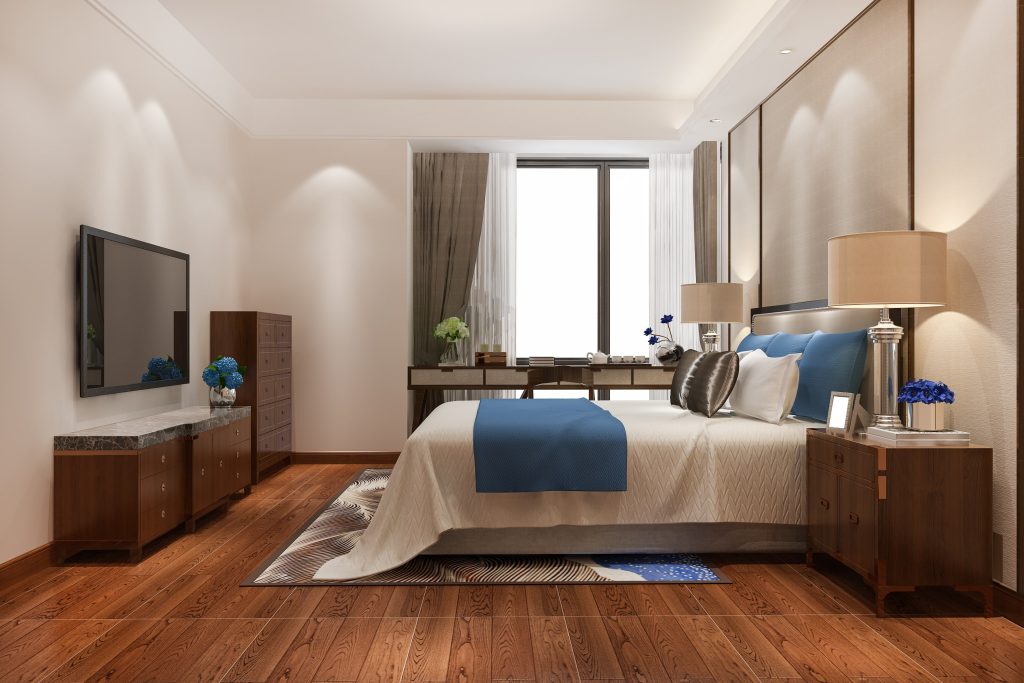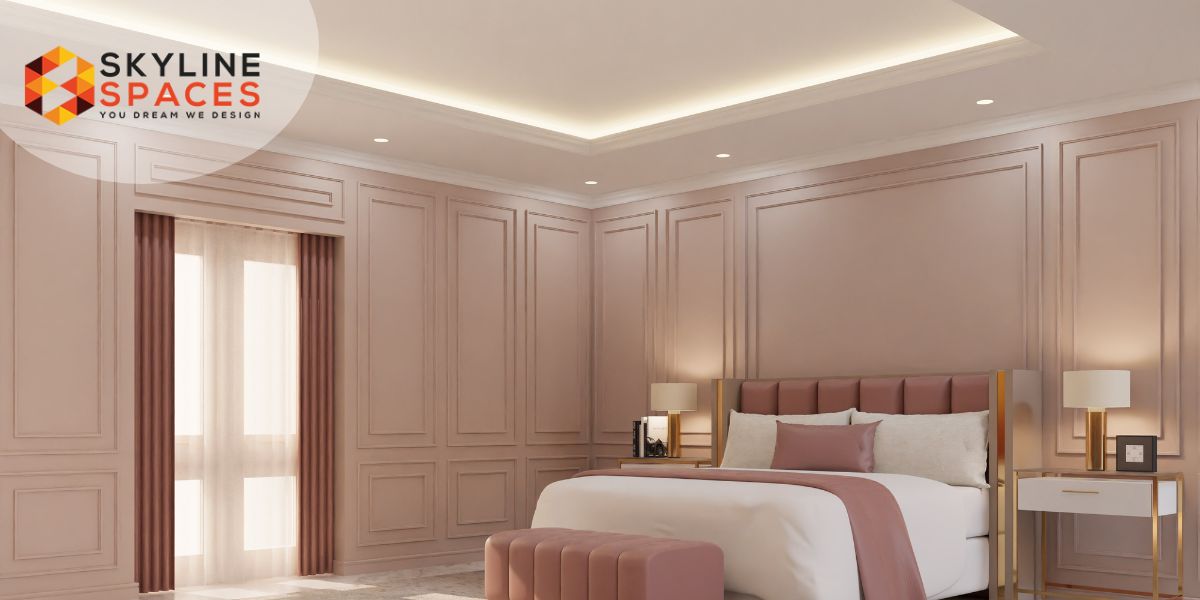A master bedroom design is all about creating a relaxing retreat that combines comfort, functionality, and personal style. From choosing the perfect colour palette to selecting the right furniture and decor, every element plays a crucial role in transforming your space into a sanctuary. Explore various design ideas that cater to different tastes, whether you prefer a modern minimalist look, a cosy rustic vibe, or a luxurious classic ambience. With thoughtful planning and creative touches, you can create a master bedroom that truly reflects your personality and enhances your overall well-being.
The Ultimate Guide to Master Bedroom Cabinet Design

1. Neutral Color Palette
A neutral colour palette in the master bedroom design ideas fosters a serene and calming environment, perfect for relaxation. Shades of white, beige, and grey can make the space feel larger and more open. Neutral colours also provide a versatile backdrop, allowing you to easily switch up accessories and decor without clashing with the room’s base colours.
2. Statement Headboard
A statement headboard can instantly elevate the look of your master bedroom design simple. Opt for bold designs, such as tufted upholstery, intricate wood carvings, or metal frames. This focal point not only adds visual interest but also enhances the room's overall aesthetic, making the bed the centrepiece of your space.
3. Layered Bedding
Layered bedding adds a luxurious and cosy feel to your master bedroom. Start with high-quality sheets, add a comforter or duvet, and finish with throws and decorative pillows. This layering not only looks inviting but also provides flexibility in adjusting warmth and comfort throughout the year.
4. Minimalist Furniture
Choosing minimalist furniture helps maintain a clean and uncluttered look in the master bedroom design interior. Opt for pieces with simple lines and neutral finishes. This approach maximizes space and creates a tranquil environment, free from the distractions of overly ornate or bulky furniture.
5. Accent Wall
An accent wall can transform the look of your master bedroom cabinet design by adding depth and character. Use bold paint colours, patterned wallpaper, or textured materials like wood or stone. This single wall becomes a visual focal point, breaking the monotony and adding a personalized touch to the room.
6. Ambient Lighting
Ambient lighting is crucial for creating a warm and inviting atmosphere in your master bedroom. Combine different lighting sources, such as bedside lamps, pendant lights, and wall sconces, to achieve layered illumination. Dimmable lights allow you to adjust the brightness to suit various activities and moods.
7. Textured Elements
Incorporating textured elements into your master bedroom interior design furniture adds depth and interest. Use a mix of materials like soft rugs, knitted throws, and velvet cushions. These textures create a sensory-rich environment that feels cosy and inviting, enhancing the overall comfort of the space.
8. Greenery
Adding greenery to your master bedroom design furniture brings a touch of nature indoors. Plants not only improve air quality but also add a refreshing and vibrant feel. Choose low-maintenance varieties like succulents, snake plants, or ferns to ensure your bedroom remains a stress-free sanctuary.
9. Personal Touches
Personal touches make your master bedroom uniquely yours. Display family photos, cherished artwork, or souvenirs from travels. These items infuse the space with personality and warmth, making it a true reflection of your style and memories, and enhancing the emotional connection to your room.
10. Functional Storage
Functional storage solutions keep your master bedroom organized and clutter-free. Invest in built-in wardrobes, under-bed storage, and stylish dressers. Efficient storage not only maximizes space but also ensures that everything has its place, contributing to a calm and orderly environment.

How Can I Make the Most of a Small Master Bedroom?
Making the most of a small master bedroom involves creative space-saving solutions and thoughtful design choices. Here are some tips to maximize your small master bedroom:
- Optimize Furniture Placement: Arrange your furniture to maximize floor space. Consider placing your bed against the longest wall to free up walking space.
- Choose the Right Size Bed: Opt for a bed that fits comfortably in the room without overwhelming it. A queen-sized bed is usually a good balance between comfort and space.
- Utilize Vertical Space: Install shelves or wall-mounted storage units to keep items off the floor and create more storage space for books, decorative items, or personal belongings.
- Use Multi-Functional Furniture: Look for furniture pieces that serve multiple purposes, such as a bed with built-in storage drawers or a bedside table with shelves or drawers.
- Keep it Clutter-Free: Avoid overcrowding the room with too many decorative items or furniture pieces. Keep only essential items and consider minimalistic decor to create a more spacious feel.
- Opt for Lighter Colors: Lighter colours on walls, furniture, and bedding can make the room feel larger and more open. Use a cohesive colour scheme to create a sense of unity and space.
- Maximize Natural Light: Use sheer curtains or blinds that allow natural light to filter through. Natural light can make a small room feel brighter and more spacious.
- Create a Focal Point: Designate a focal point in the room, such as an accent wall, artwork, or a statement piece of furniture. This draws attention away from the room's size and adds visual interest.
- Mirrors: Strategically placing mirrors can give the illusion of more space by reflecting light and creating depth. Consider a large mirror or a collection of smaller mirrors on one wall.
- weight on one area. Distribute furniture and decor evenly to create a harmonious feel.
By implementing these tips, you can transform your small master bedroom into a cozy and functional space that feels larger and more inviting.
What Colors Work Best for Master Bedroom Lighting Design
Choosing the right colours for master bedroom lighting design involves considering both the light fixtures themselves and the overall ambience you want to create. Here are some considerations for selecting colours:
- Light Fixture Colors:
- Metallic Finishes: Metallic finishes like chrome, brushed nickel, or brass can complement various design styles and reflect light effectively.
- Neutral Finishes: White or off-white light fixtures blend well with most color schemes and create a clean, modern look.
- Black or Dark Finishes: These can add contrast and drama, but be mindful of how they blend with other elements in the room.
- Ceiling Color:
- White: A white ceiling reflects light and helps to brighten the room. It also makes the ceiling appear higher, creating a sense of spaciousness.
- Light Neutral Tones: Light shades of beige, gray, or even a soft pastel can create a calming effect and complement various decor styles.
- Wall Colors:
- Soft Neutrals: Shades like light grey, taupe, ivory, or pale shades of blue or green can create a serene atmosphere and work well with various lighting designs.
- Warm Tones: Soft warm tones like light peach, blush pink, or creamy yellows can add warmth and cosiness to the room, enhancing the lighting ambience.
- Accent Wall or Feature Colors:
- Bold or Dark Colors: If you want to add a dramatic touch, consider painting one wall in a deeper shade such as navy blue, charcoal grey, or deep forest green. This can create a focal point and add depth to the room.
- Subtle Patterns: Wallpaper or textured paint in subtle patterns or tones slightly darker or lighter than the main wall colour can add visual interest without overwhelming the space.
- Lighting Fixture Shades:
- Opaque or Frosted Shades: These can diffuse light softly, creating a gentle and even illumination that enhances the room's ambience.
- Transparent or Clear Shades: These allow more direct light to pass through, providing brighter illumination that works well in task areas like reading nooks.
- Overall Color Scheme:
- Coordinated Palette: Aim for a coordinated colour palette that includes your lighting fixtures, ceiling, walls, and any accent colours or decor elements. This creates a harmonious look and enhances the overall feel of the room.
Always consider natural light sources and how they interact with your chosen colours throughout different times of the day. Experimenting with sample swatches or smaller areas before committing to a colour scheme can also help ensure you achieve the desired lighting design for your master bedroom.
Tips for Maximizing Space in Your Master Bedroom
Maximizing space in a master bedroom design furniture, especially in smaller or more compact rooms, involves strategic planning and efficient use of available square footage. Here are some practical tips to help you make the most of your space:
- Choose the Right Size Bed: Opt for a bed that fits comfortably in the room without overwhelming it. A queen-sized bed is usually a good compromise between space and comfort.
- Utilize Under-Bed Storage: Invest in a bed frame with built-in drawers or use bed risers to create extra storage space underneath for items like seasonal clothing, bedding, or shoes.
- Multi-Functional Furniture: Select furniture pieces that serve more than one purpose. For example, a bedside table with drawers or shelves can double as storage for books or personal items.
- Wall-Mounted Shelves and Storage: Install shelves or wall-mounted storage units to keep items off the floor and maximize vertical space. This is great for displaying decor or storing books and accessories.
- Maximize Closet Space: Use closet organizers, hanging shelves, or modular storage systems to maximize the efficiency of your closet space. Consider using slim hangers to optimize hanging space.
- Foldable or Compact Furniture: Choose furniture that can be easily folded or collapsed when not in use, such as folding chairs or tables. This allows you to create more space when needed.
- Utilize Corners: Corners often go unused, but they can be valuable space-saving areas. Consider corner shelves, a corner desk, or a corner wardrobe to maximize storage without taking up much floor space.
- Mirrors to Create Depth: Strategically place mirrors to create the illusion of more space and reflect natural light. A large mirror on one wall can make the room feel larger and brighter.
- Keep Clutter to a Minimum: Avoid overcrowding your bedroom with unnecessary furniture or decor items. Keep surfaces clear and organized to create a more spacious and relaxing atmosphere.
- Lighter Colors and Minimalist Design: Opt for lighter colors on walls, furniture, and bedding to create a sense of openness and airiness. A minimalist design approach can also help to visually expand the room.
By implementing these tips, you can transform your master bedroom ideas for small rooms into a functional and organized space that feels larger and more comfortable, regardless of its size.
Conclusion
Designing your master bedroom is an opportunity to create a space that blends comfort, functionality, and personal style into a serene retreat. Whether you lean towards a modern minimalist aesthetic, a cozy rustic feel, or a luxurious classic ambiance, every element—from colour palettes to furniture choices—plays a pivotal role. By focusing on thoughtful planning and incorporating creative touches like ambient lighting, textured elements, and efficient storage solutions, you can transform your master bedroom into a sanctuary that not only reflects your personality but also enhances your overall well-being. Embrace these design ideas to craft a space where relaxation and rejuvenation seamlessly coexist, making your master bedroom the ultimate haven.
Trust. Skyline Spaces brings your dream kitchen to life with the best interior bedroom designs and modular kitchen design furniture tailored to your needs.



